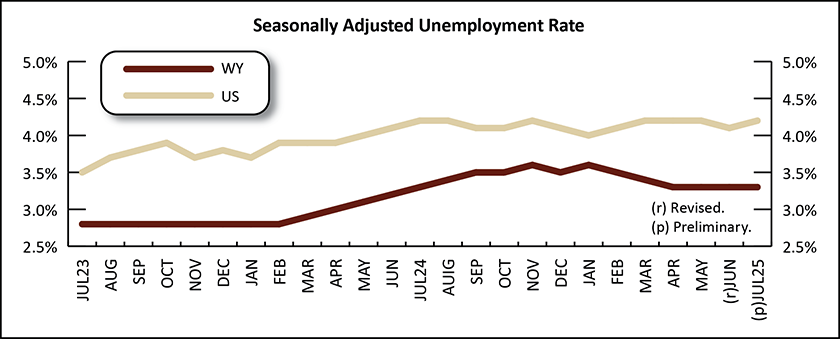Wyoming Labor Force Trends
September 2025 | Volume 62, No. 9
Click Here for PDF
Return to Table of Contents
Wyoming Unemployment Steady at 3.3% in July 2025
by: David Bullard, Senior Economist
The Research & Planning section of the Wyoming Department of Workforce Services reported that the state’s seasonally adjusted1 unemployment rate held steady from June to July at 3.3%. Wyoming’s unemployment rate was unchanged from its July 2024 level and lower than the current U.S. rate of 4.2%.
From June to July, county unemployment rates followed their normal seasonal pattern and decreased. Unemployment rates often fall in July because of seasonal job gains in construction, leisure & hospitality, and professional & business services. The largest unemployment rate decreases occurred in Sheridan (down from 3.6% to 2.5%), Hot Springs (down from 3.9% to 2.8%), Goshen (down from 4.1% to 3.0%), and Carbon (down from 4.4% to 3.3%) counties.
From July 2024 to July 2025, unemployment rates fell in 19 counties, rose slightly in three counties, and remained unchanged in Goshen County (3.0%). The largest decreases were seen in Weston (down from 3.1% to 2.4%), Laramie (down from 3.4% to 2.8%), Sheridan (down from 3.0% to 2.5%), and Johnson (down from 2.7% to 2.2%) counties. Niobrara County’s unemployment rate rose from 2.6% to 3.3%.
In July, the lowest unemployment rates were found in Teton County at 1.4%, Crook County at 2.1%, Lincoln County at 2.2%, and Johnson County at 2.2%. The highest rates were reported in Big Horn County at 3.6%, Fremont County at 3.5%, and Sweetwater County at 3.5%.
Current Employment Statistics (CES) estimates show that total nonfarm employment in Wyoming (not seasonally adjusted and measured by place of work) rose from 299,200 in July 2024 to 301,300 in July 2025, an increase of 2,100 jobs (0.7%).
R&P's most recent monthly news release is available at https://doe.state.wy.us/LMI/news.htm.



 Hire Wyo
Hire Wyo